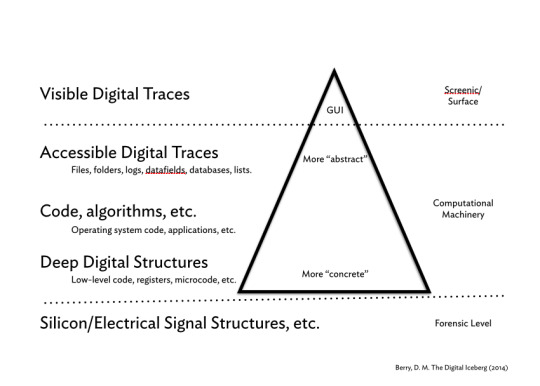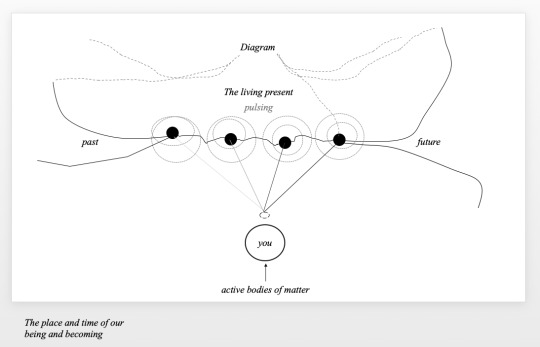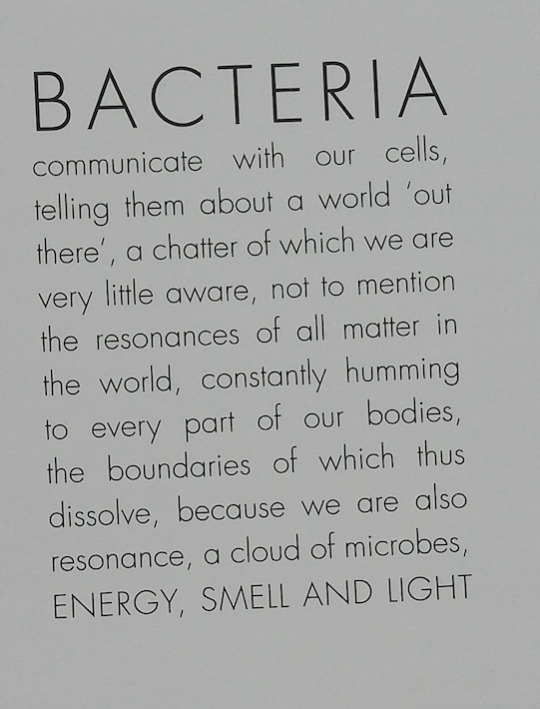This will be an ongoing, live space to think through thoughts, research and practice.
Don't wanna be here? Send us removal request.
Link
0 notes
Link
0 notes
Text
Bibliography
Web Sources
Doruff, S. (2008) Diagrammatic Praxis https://www.ahk.nl/fileadmin/download/ahk/Lectoraten/doruff-diagrammatic-praxis.pdf [19 October 2019]
Kenning, D. (2012) Metallurgy of the Subject https://www.academia.edu/2269562/Metallurgy_of_the_Subject[14th May 2019]
Montgomery, N. (2019) Summary: Vibrant Matter by Jane Bennetthttps://cultivatingalternatives.com/2013/11/28/summary-vibrant-matter-by-jane-bennett/ [18th October 2019]
Shin, S. Lemon, O. Mumma, J. (2018) Stanford Encyclopaedia of Philosophy: Diagrams https://plato.stanford.edu/entries/diagrams/ [11th November 2019]
Latour, B. (2014) Opening Plenary, Digital Humanities 2014 (DH2014), available from http://dh2014.org/videos/opening-night-bruno-latour/
Journal and Article Sources
Ansell-Pearson, K. (2005) The Reality of the Virtual: Bergson and Deleuze MLN 120 (5) [online] Available at: https://www.jstor.org/stable/3840700
Dwiartama, A. Rosin, C. (2014) Exploring Agency Beyond Humans: The Compatibility of Actor Network Theory (ANT) and Resilience Thinking Ecology and Society 19 [online] Available at: https://www.ecologyandsociety.org/vol19/iss3/art28/
Frichot, H. (2014) On the becoming-indiscernible of the diagram in societies of control Journal of Space Syntax5 (1) 1-14 [online] Available at: https://pdfs.semanticscholar.org/a54c/8de58820694a63c06602db665a4ef9cb86f9.pdf
Hanley, C. (2019) Thinking with Deleuze and Guattari: An Exploration of Writing as Assemblage Educational Philosophy and Theory 51 (4) 413-423 [online] Available at: https://doi.org/10.1080/00131857.2018.1472574
Johnston, J. (1999) Mechanic Vision Critical Enquiry 26 (1) 27-48 [online] Available at: https://www.jstor.org/stable/1344144?seq=1#metadata_info_tab_contents
O’Sullivan, S. (2005) Four Moments/Movements for an Expanded Art Practice (following Deleuze, following Spinoza) Issues in Contemporary Aesthetics 67-69 [online] Available at: https://www.simonosullivan.net/art-writings/four-moments.pdf
Rodda, M. (2014) The Diagrammatic spectator Ephemera theory & politics in organization 14 (2), 221-244 [online] Available at: http://www.ephemerajournal.org/contribution/diagrammatic-spectator
Sayes, E. (2013) Actor-Network Theory and methodology: just what does it mean to say that nonhumans have agency? Social Studies of Science 44 [online] Available at: https://journals.sagepub.com/doi/abs/10.1177/0306312713511867
Teyssot, G. (2012) The Diagram as Abstract Machine V!RUS 5 [online] Available at: https://pdfs.semanticscholar.org/833c/71403c79675fd83be6785ca9195c87aca447.pdf
Vellodi, K. (2014) Diagrammatic Thought: Two Forms of Constructivism in C.S Peirce and Gilles Deleuze Parrhesia 19 79-95 [online] Available at: http://parrhesiajournal.org/parrhesia19/parrhesia19_vellodi.pdf [02 December 2019
Books
Bennett, J. (2010) Vibrant Matter: A Political Ecology of Things London: Duke University Press
Cixous, H. (1993) Three Steps on the Ladder of Writing. New York: Columbia University Press.
Deleuze, G. (1988) Foucault London: Athlone
Deleuze, G. Guattari, F. (1987) A Thousand Plateaus London: University of Minnesota Press
O’Sullivan, S. (2016) On the Diagram (and the Practice of Diagrammatics) New York: Dominque Levy
O’Sullivan, S. Morgan, A. (ed) (2017) The Finite-Infinite Relation: A Conversation with Simon O’SullivanNewcastle: Bigg Books
Latour, B. (1972) Network: A Concept, Not a Thing Out There Networks: Documents of Contemporary ArtLondon: MIT Press
Massumi, B. (2011) Semblance and Event: Activist Philosophy and the Occurent Arts. Cambridge: MIT Press
Dewey, J. (1934) Art As Experience. New York: The Berkley Publishing Group
Latour, B. (2005) Reassembling the social: An introduction to actor-network-theory. Oxford: Oxford University Press
Ambrožič, M. & Vettese, A. (2013) Art as Thinking Process: Visual forms of Knowledge Production. New York, Sternberg Press
Saper, C. (2014) Networked Art Networks: Documents of Contemporary Art London: MIT Press.
Simondon, G. (1958) On the Mode of Existence of the Technical Object. Paris: Aubier.
Krysa, J. (2006) Curating Immateriality: The Work of the Curator in the Age of Network Systems. Poland: LEGA.
Lecture Notes
Bennett, J. (2011) Powers of the Hoard: Artistry and Agency in a World of Vibrant Matter Lecture notes. Vera List Center for Art and Politics, delivered 13th September 2011. Available at: https://www.youtube.com/watch?v=q607Ni23QjA
Kenning, D. (2019) Exploratory Diagrams Lecture notes. Diagramming Research, Plymouth University, Delivered 13th May 2019.
Rosser, L. 2019. Diagrammatic Misadventures Lecture notes. University of Plymouth, Delivered: Wednesday 13th March 2019.
1 note
·
View note
Photo

Found at: http://stunlaw.blogspot.com/2014/08/on-latours-notion-of-digital.html
1 note
·
View note
Photo








Are they notes? Forgotten thoughts that lead you to this place, the forgotten quiet matter that drifts by you, but affects you completely. Should it just be relevant thoughts? Now thoughts? Before, I wouldn’t place the content with the atom because it was about the shifting, drifting thoughts we have. This feels like it is making them static - permanent almost?
0 notes
Photo










Wondering whether each thought atom is a diagram - leading to this moment?
1 note
·
View note
Photo




I was reflecting on why the site of the studio, created such a vibrant exchange, and how I am only accessing the testspace through my thoughts and memories. I can’t help but be drawn back to the thing I responded to: thing power. I am stitching together a fragmented, warped, version of events. I try to think of the imprints, the editing of the site, the collaboration - but a lot of the information has been lost. These images are interesting because they convey that. There’s an urgency, a searching for something that has been removed.
0 notes
Photo

Looking back at what was the installation before lockdown.
0 notes
Video
tumblr
Thought Atoms drifting by - this software allows me to keep that collaborative, open exchange with the audience who view my work. They will be in control of the Thought Atoms. Interesting how it has come full circle. Now I just have to store information in them.
0 notes
Photo



I’m thinking about the information that I need to put into my virtual (testspace) diagram, and my initial path was about keeping that archive of thoughts, feelings, imagery, information that I had digested in order to be here. However, I now see that there’s so much of it, it would have to be either filtered or set aside elsewhere (like on here). This made me think, that when I was engaging in ‘testspace’ it was live? It was about connections being made, unfolding thoughts, the binding of the past, present and future. In an ideal world, this would be live and interactive, but that is for another day.
With this idea in mind, I could have questions or thoughts that remain with me now. I am still thinking about the internet, the immaterial, the diagram, thought to matter. I will test these short snippets of thoughts/information, and review it with someone other than me.
0 notes
Video
tumblr
Testing out some interesting software - an alternative to a linear type blog. Not sure about how complex it is, but trial and error will help with that. The colours feel a little too science based for me, I think I might experiment with monochromes and for the spheres to be a little more densely populated.
0 notes
Photo

Above: image from On the Diagram (and a Practice of Diagrammatics) - Simon O’Sullivan.
0 notes
Text

In these paintings I was kind of keeping matter alive within my networks. Its very easy to shift everything online, work digitally and exist in a virtual personality. I thought it was important to visualise the internet, or the virtual departure of thought, on a flat plane, utilising material that embed your fingertips and feel lively.
0 notes
Photo

Cranial Uploads (The Thought Network shifting from actual to virtual), 2020
0 notes
Photo

Today I am reviewing what this means to me now. Do I re-make this to fit a virtual body? I’m thinking about making a collage inspired by this process of being and becoming (online), maybe incorporating this challenging idea of thoughts being lost in the internet?
0 notes

